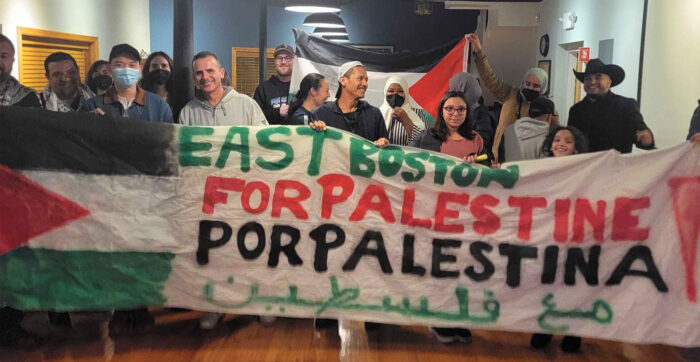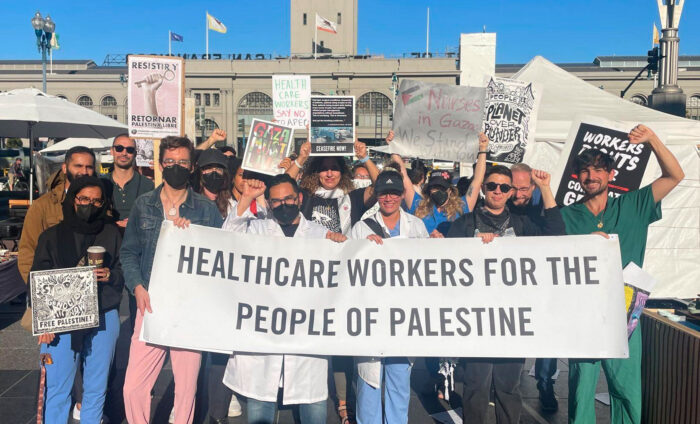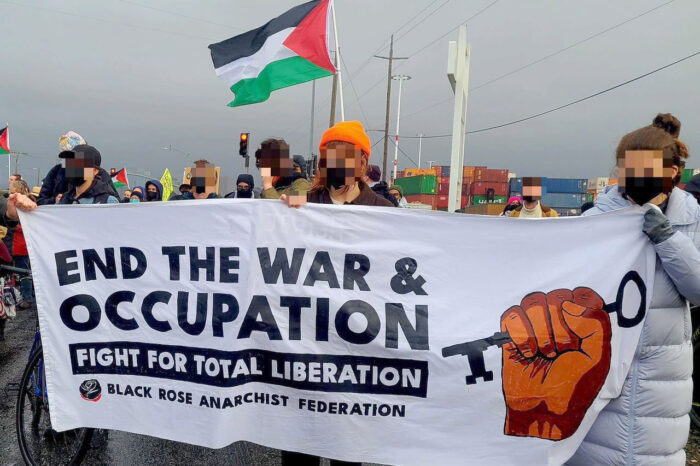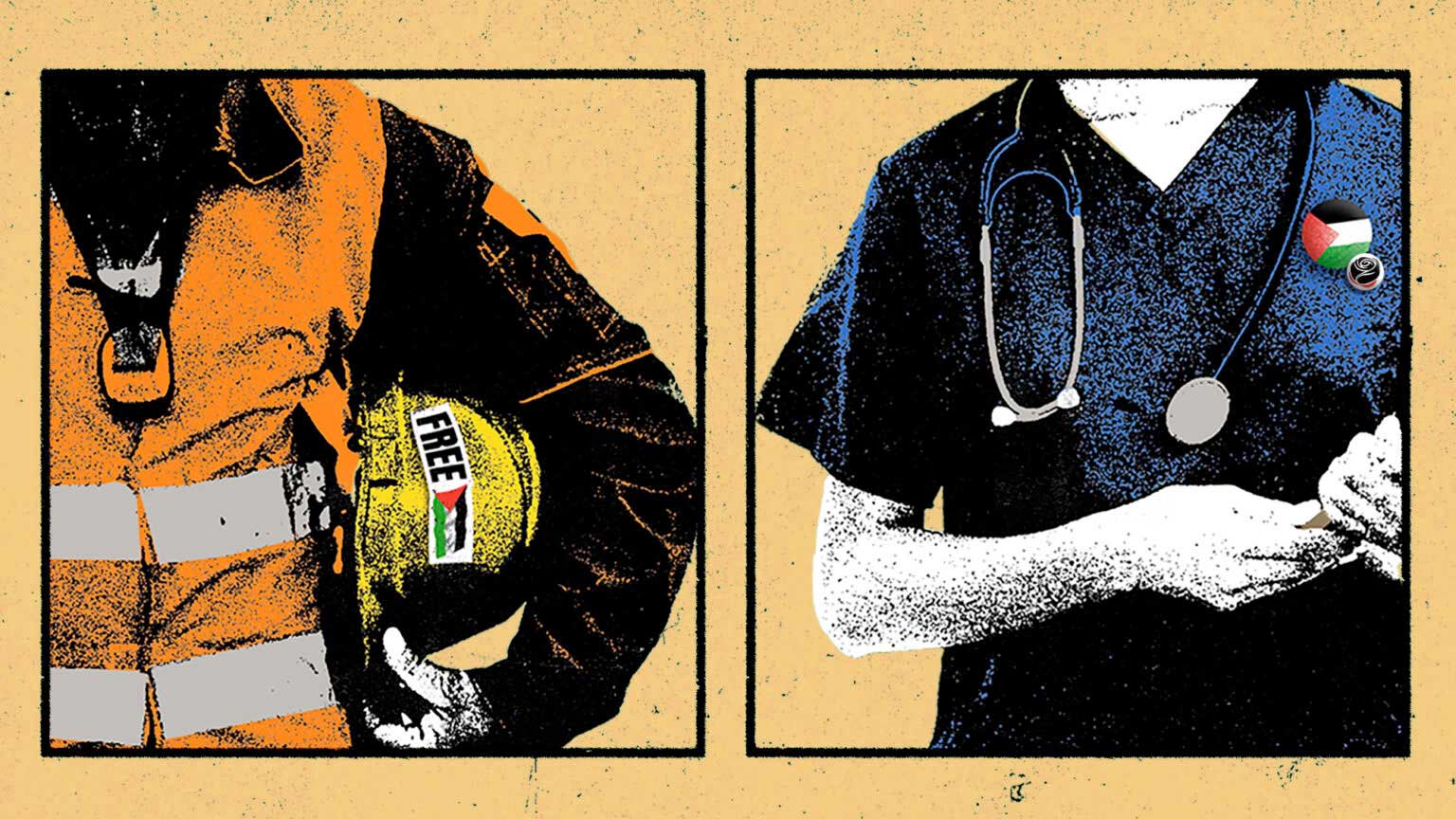In this article several members of Black Rose / Rosa Negra offer reflections on their efforts to bring the fight for Palestinian liberation into their long term organizing efforts. Throughout, an emphasis is made on the distinction between temporary mobilization and an orientation toward sustained organizing in sites of everyday life—our workplaces, schools, and neighborhoods.
Introduction
More than 100 days into Israel’s genocidal assault on the people of Palestine and in turn some of the most vigorous anti-war mobilization in over a decade, so many of us who have been out in the streets have asked: What will it take to actually stop the US war machine?
Reflecting on the 2003 protests against the invasion of Iraq, it’s clear it takes more than marching from point A to point B—and even more than scattered direct actions like taking over highways, occupying politicians’ offices, or minor vandalism. Coming out into the streets, pouring our energy into actions, escalating to risk arrest, disrupting business as usual, and then feeling exhausted and defeated is a common cycle in the anti-war movement and in every struggle.
Many of us in Black Rose / Rosa Negra (BRRN) first came to the organization because we had grown tired of the cyclical nature of activism. We were reacting to crises just to end back up where we started, only with depleted morale and fewer resources. We wanted to find ways to gather and sustain momentum, retain historical memory, tend to the needs of movement participants, and build leverage to win fights in the here and now—all to the ends of pushing toward a revolutionary rupture. This is one reason why BRRN prioritizes rooted movement-building where we live, work, and study and thus seek to move away from a focus on single-issue campaigns and activist subcultures.
Admittedly, because we are still in the early stages of re-building fighting social movements, it can make mobilizing around emergencies like the genocide in Palestine slower. This is in part because we are organizing with heterogeneous groups of people and trying, for example, to bring our coworkers to actions, rather than to mobilize other radicals or activists. We believe that this approach will ultimately be more effective because we are building lasting organization in rooted sites of everyday struggle that can respond swiftly to future struggles as well. We seek to do the organizing work of bringing new people into social movements and the political work of bringing them toward organized anarchism, so that there will be more prepared militants down the line. We know that organized, rather than simply mobilized, political struggle is far more effective in challenging imperialism in moments of crisis.
Our approach often flies under the radar. For one, it prioritizes acting in broader social movement spaces as co-equal participants, rather than placing an emphasis on ensuring our brand as a political organization is visible on every call for mobilization or protest sign. While we also organize and participate in large marches and other actions, believing that they are necessary component of any social movement struggle, these are not the core of what we focus on. Because of the aforementioned lack of visibility, combined with how important we think this organizing model is for actually building power, we want to highlight some of the less visible work that our membership is engaged in around Palestine solidarity.
This is not to show how to do things “the right way”, but to show how in a variety of different contexts we can all do the basic—and often very modest but necessary—work of building the foundations of movements so that we end up with more comrades, power, and solidarity than we started with. At the end of a lot of Palestine solidarity marches, the speakers make calls to go out and keep organizing because marches alone can’t stop Israel’s genocidal attack—this is objectively true, but it’s often unclear what that can look like, particularly for rank-and-file militants outside of the professionalized NGO and union bureaucracy systems. So what could these next steps look like? Here are some examples of what members of Black Rose / Rosa Negra have found success with.
Neighborhood Organizing in Boston

Tony has lived in the neighborhood of East Boston for 20 years, while Roxana has lived and worked there for 6—both are members of BRRN. Their many years of organizing in the neighborhood have generated a lot of connections and relationships of trust. When the war on Gaza started, they were able to rely those long-term relationships to expand their reach and bring together many of their neighbors to attend a pro-Palestine march as a group. After reflecting on this initial effort with a number who attended, the group chose to formalize its effort by creating the East Boston for Palestine neighborhood organization. The group has since hosted discussions and film screenings in the neighborhood, bringing together immigrant families from different backgrounds to learn about and discuss the connections between their struggles against imperialism. This organizing has helped create a supportive anti-imperialist community in the neighborhood and created the foundation for organizing around other issues in the place they call home.
In the current moment, there is a huge wave of support for the Palestinian struggle. For some, it’s a political issue that they learn about through activism. For others, the connection to Palestine has its roots in being part of Muslim or Arab communities, or having experienced and resisted the violence of colonialism and imperialism directly. In order to exact a cost on the imperialist machinery, we have to find ways to bring together seemingly disparate groups of people, create lasting organization, and develop more strategic forms of resistance.
By participating in the creation of an independent pro-Palestinian organization, BRRN members in Boston have been able to avoid many of the political limitations foisted on struggles by non-profit organizations, top-down labor unions, or the Democratic Party. In focusing on a specific geography like a neighborhood, we are able to develop relationships rooted in a site of everyday life, instead of trying to grow insular activist cliques united around little more than ideology or a particular issue. This grants us the ability to collectively make sense of the current moment and its historical roots. We make connections of political and social solidarity in a process that builds a shared world view. It also creates an accessible outlet for action for so many people that feel the urge to stand in solidarity, but may be new to the movement, or feel marginalized by “professional activism.”
You can find East Boston for Palestine on Instagram at @ebxpal.
Healthcare Worker Organizing in Oakland

Morgan is a nurse in Oakland who originally started organizing with BRRN when she took part in planning a “Healthcare Workers for Black Lives” demonstration in 2020. Three years later, the connections made then have become central to organizing efforts happening now, as healthcare workers come out to support Palestine. Workers at every major healthcare institution in the Bay Area have mobilized and begun forging more extensive bonds with each other through a combination of previously existing political connections, a national petition that connected signatories, visibility at marches, word-of-mouth, and ever-growing Signal and WhatsApp group-chats.
It’s in this context that Morgan sought to take the organizing around the Palestine issue into her hospital. Initially meeting with a small nucleus of like minded staff at her hospital, the group coalesced around a plan to hold a daily outreach table in the hospital’s courtyard, which sought to connect with and educate coworkers around Palestinian liberation. Bringing in more participants allowed her to host an online teach-in on the Palestinian experience and brain trauma with a local Palestinian MD, co-organize an internal gathering of about 50 coworkers, and later hold public rally for Palestine in front of the hospital.
In the current moment the campaign has taken a longer-term view, with Morgan and her coworkers pushing for the hospital to divest from militarist and BDS-targeted corporations, establish a sister hospital relationship with a Palestinian hospital, and protect staff from any retaliation for speaking out on Palestine. This organizing has been greatly enhanced by Morgan’s history as a rank-and-file union activist at the hospital, and helped to expand her political relationships at the hospital beyond her union and across different departments and professions. Morgan believes that the relationships she has built through this process, most of which are at the hospital where she intends to work for the rest of her career, have formed a foundation from which future fights can be waged.
As a member of Service Employees International Union (SEIU), Morgan’s union involvement has created even more opportunities for organizing outside of just her own workplace. The union local to which she belongs is massive, covering much of Northern California. In the local, members initially organized for a ceasefire statement, and then an even stronger resolution that called for 1) an immediate and permanent ceasefire, 2) the end of all military aid to Israel, and 3) an end to the occupation of Palestine.
Morgan and other rank-and-file SEIU members are building relationships that can take this organizing beyond just paper resolutions, in the hopes that these actions will lead to enduring cross-industry organizing structures. On a national level Morgan has participated in the “Purple Up for Palestine” campaign to call on SEIU as a whole to demand a ceasefire. The campaign has successfully pressured SEIU’s union president to release a statement calling for a ceasefire. This effort too has presented another opportunity to connect directly with other workers outside of formal and often bureaucratized union structures.
Further Healthcare Worker Organizing in the Bay Area

On the other side of the Bay from Morgan is Grant, a long time member of BRRN who recently started working at an academic medical center. Unlike Morgan, Grant’s hospital is mostly non-union. With almost no existing structures connecting workers together, and no history of activism at the hospital, pro-Palestine workers were starting from scratch. Fortunately a few individuals were able to connect through a national healthcare workers for Palestine petition. From those initial connections, Grant and other hospital workers were able to grow a loose network of several dozen supporters, with pockets of organizing in a couple of hospital departments and the attached medical school. They were able to expand their base of support by organizing two demonstrations at the hospital which involved more than a hundred of their co-workers.
In a previously disorganized and seemingly apolitical environment, the Palestine solidarity organizing that Grant played a key role in pushing forward has created lasting connections between worker organizers across the hospital. Without this system-wide effort, many of these coworkers would not have encountered each other, let alone taken workplace action together. These efforts have demonstrated to workers that their workplace is a site of political struggle, inspired new activists to step up, and has been a means of supporting Palestinian workers in the hospital who are suffering most directly in the midst of the ongoing genocide.
As BRRN militants and healthcare workers in the Bay, both Grant and Morgan have also been participating together in the regional organizing that is happening between hundreds of healthcare worker activists. Recently this culminated in a healthcare worker-led action that shut down the offices of L3Harris, a weapons industry company whose bombs have been dropped on hospitals in Gaza. Together with members of this growing network, Grant and Morgan are sinking roots into the hospitals and clinics across the Bay, where healthcare workers have become open to uniting in an unprecedented way.
Student Organizing in the Bay Area

As a first-year university student and integrating BRRN member, Dioretsa has been organizing around Palestinian liberation on her campus. Unlike the other examples in this article, Dioretsa’s university had an existing structure for Palestine activism, including an active chapter of Students for Justice in Palestine and various left-oriented student groups. These groups were able to respond quickly and initiate a series of large rallies, teach-ins, and an ongoing sit-in protest that became a visible hub of Palestine solidarity. With this current moment proving to be such a radicalizing experience for many, it has been important to provide easily accessible spaces like the sit-in where new people can come, make connections, and learn. The sit-in as a center for organizing activity has also brought together a core of student activists who will likely be at the heart of future leftist organizing.
As winter quarter began, the students launched a divestment campaign targeting the university’s ties with Hewlett-Packard (HP). HP is being targeted because of its business contracts providing IT services to the Israeli apartheid regime and its intimate links with the university. Student organizers also seek to forge and sustain a mass campus alliance beyond the issue of Palestine through this campaign. Dioretsa’s role as coalition coordinator for the divestment campaign makes her a nexus of various student organizations as well as Bay Area and national Palestine solidarity groups.
Bringing groups like the campus student-worker solidarity group (which Dioretsa is also a member of) into the divestment campaign coalition requires a lot of political work to show such groups how the fight against US imperialism and settler colonialism also concerns them. Rather than just focusing on bringing the already-committed Palestine activists together to fight for Palestinian liberation, Dioretsa and her fellow organizers recognize the campaign will only be successful if it goes beyond the “active club” model of action by building a base across all the different sectors of the university. That includes the different undergrad groups, as well as law students, faculty, campus service workers, medical students, healthcare workers, lab workers. In a word: everyone.
An Instance of BDS Workplace Organizing in the Southwest
Joe does remote work for an environmental consulting company in the Southwest. The company is involved in permitting for development projects in the US and abroad. After October 7th, he learned that one of the projects he was working on was for an Israeli firm headquartered about 30 miles from the Jabalia refugee camp. Another assignment was for a transnational energy corporation on the boycott list for extracting offshore gas on the Gaza coast. Joe reached out to some of his close coworkers to open up a discussion about the Boycott, Divestment, Sanctions (BDS) campaign. Joe let them know he would be refusing to work on these two projects and further would reject work on any future projects involving companies complicit in the genocide in Palestine.
While his coworkers were sympathetic and had reservations of their own about some of the work they have been asked to do, they were not ready to refuse the work together with him yet. Without a commitment to collective action, Joe’s individual action wasn’t enough to put a stop to these projects, but he’s been able to make space to talk with his coworkers about what role their labor may play in advancing or slowing down settler colonialism, environmental justice, and global solidarity. It can be very hard to convince our co-workers to take brave steps like this, but it’s important that we’re there to act as courageous examples and as patient explainers. With consistent effort there is a huge amount of power that workers in sectors like this have to disrupt the colonial economy.
Conclusion

With this article we have hoped to illustrate how, by talking to and taking action with the people who we work, live and study alongside of, we can build a strong base for anti-imperialist struggle. While the examples here are small, they are powerful because of the deep and lasting organizing ties that form the necessary foundation of strong collective action. We seek to unite these local efforts into wider social movements where working people can democratically wield the power needed to bring down empire.
To propel these efforts in potentially revolutionary directions, we believe that it is important to continue to: organize in sites rooted in everyday life; develop mechanisms of open and democratic decision making that exercise rank-and-file/bottom up control; analyze and pick effective targets that are materially connected to Israel’s war and occupation; and initiate campaigns that really, directly impact those targets (distinct from largely symbolic actions that many hopeful radicals have grown frustrated participating in).
The task at hand—to halt US efforts to underwrite and supply the means for a genocide of the Palestinian people—will not be easily won, so we need to be in it for the long haul. Focusing our efforts in rooted movement organizing will help us avoid the cyclical burnout of activist protest by creating a sustainable internationalist and anti-imperialist power from below.
If you enjoyed this article and want to read more about our approach to embedded organizing, we recommend Going On the Offensive: Movements, Multisectorality, and Political Strategy and Create a Strong People: Discussions on Popular Power.

